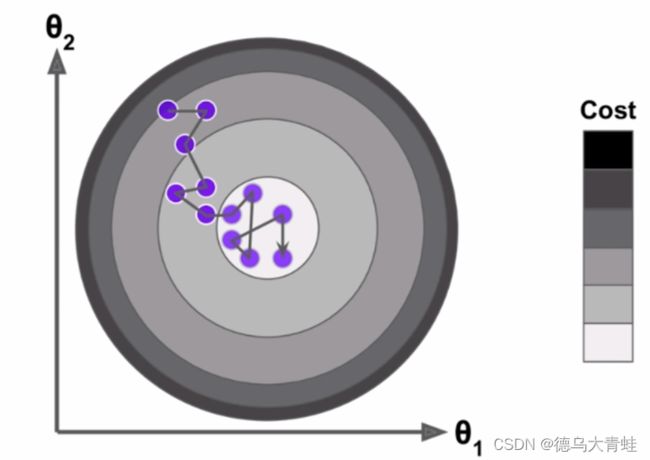梯度下降法原理及python实现
文章目录
- 引言
- 梯度
- 单变量梯度下降法
-
- 单变量梯度下降原理
- python实现单变量梯度下降
- 批量梯度下降法
-
- 批量梯度下降法原理
- python实现多变量梯度下降
- 梯度下降算法数据归一化
- 随机梯度下降法
-
- 随机梯度下降原理
- python实现随机梯度下降算法
- 小批量梯度下降法
-
- 小批量梯度下降法原理
- python实现小批量梯度下降法
- sklearn实现随机梯度下降
引言
梯度下降法不是机器学习算法,不能用来解决分类或回归问题,而是一种基于搜索的最优化方法,作用是优化目标函数,如求损失函数的最小值,即梯度下降法。
梯度
梯度的本意是一个向量(矢量),表示某一函数在该点处的方向导数沿着该方向取得最大值,即函数在该点处沿着该方向(此梯度的方向)变化最快,变化率最大(为该梯度的模)。

如单变量函数y=x2,其导数为 ∇ \nabla ∇y=2*x,此时在x=2处的梯度为4,如果函数为多变量函数,梯度则为一个向量( ∂ y x 1 \quad {\partial y \over x_1} x1∂y,……, ∂ y x i \quad {\partial y \over x_i} xi∂y),梯度的方向指出了函数在给定点上升最快的方向,取负则为下降最快方向。
单变量梯度下降法
单变量梯度下降原理
假设函数为 J ( θ ) = ( θ − 2 ) 2 + 1 J(\theta)=(\theta-2)^2+1 J(θ)=(θ−2)2+1,对函数求导得到 J ′ ( θ ) = 2 ∗ θ − 4 J\prime(\theta)=2*\theta-4 J′(θ)=2∗θ−4,假设初始值为1,即 θ 0 = 1 \theta^0=1 θ0=1,学习率为0.01,即 α = 0.01 \alpha=0.01 α=0.01
根据梯度下降公式 θ 1 = θ 0 − α ∗ J ′ ( θ 0 ) \theta^1=\theta^0-\alpha*J\prime (\theta^0) θ1=θ0−α∗J′(θ0) θ 2 = θ 1 − α ∗ J ′ ( θ 1 ) \theta^2=\theta^1-\alpha*J\prime (\theta^1) θ2=θ1−α∗J′(θ1) … … …… …… θ i = θ i − 1 − α ∗ J ′ ( θ i − 1 ) \theta^i=\theta^{i-1}-\alpha*J\prime (\theta^{i-1}) θi=θi−1−α∗J′(θi−1)当 θ i \theta^i θi小于我们设置的预期值时,此时认为到达函数最低点。
python实现单变量梯度下降
def J(theta):
return (theta-2)**2+1
def dJ(theta):
return 2*theta-4
theta = 1.0
alpha = 0.01
extreme = 1e-8
while True:
last_theta = theta
theta = last_theta - alpha * dJ(last_theta)
if abs(J(theta)-J(last_theta)) < extreme :
break
print(theta)
print(J(theta))
输出
1.9995076992061676
1.0000002423600716
批量梯度下降法
批量梯度下降法原理
在线性回归分析法中,我们的目标是求得损失函数最小值 ∑ i = 1 m ( y ( i ) − y ^ ( i ) ) 2 \sum_{i=1}^m(y^{(i)}-\hat y^{(i)})^2 i=1∑m(y(i)−y^(i))2 y ^ ( i ) = θ 0 + θ 1 X 1 ( i ) + θ 2 X 2 ( i ) + … … + θ n X n ( i ) \hat y^{(i)}=\theta_0+\theta_1X^{(i)}_1+\theta_2X^{(i)}_2+……+\theta_nX^{(i)}_n y^(i)=θ0+θ1X1(i)+θ2X2(i)+……+θnXn(i)对所有 θ \theta θ求导得

X b X_b Xb为矩阵 X X X左边加一列1,为了使得求出的梯度和样本 m m m无关,对损失函数除以 m m m,得到

最终得到的结果是一个矩阵运算
python实现多变量梯度下降
import numpy as np
#损失函数
def J(theta,x_b,y_train):
return np.sum(y_test-x_b.dot(theta))**2 / len(y_train)
#对损失函数求导
def dJ(theta,x_b,y_train):
return x_b.T.dot(x_b.dot(theta) - y_train) * 2. / len(x_b)
#梯度下降
def gradient_descent(x_b,y_train,initial_theta,alpha,n_iters = 1e4,epsilon = 1e-8):
theta = initial_theta
#梯度下降次数
i_iter = 0
while i_iter<n_iters:
gradient = dJ(theta,x_b,y_train)
last_theta = theta
theta = theta-alpha*gradient
if abs(J(theta,x_b,y_train) - J(theta,x_b,y_train)) < epsilon :
break
i_iter += 1
return theta
#测试数据集测试
from sklearn.datasets import load_boston
from sklearn.model_selection import train_test_split
boston = load_boston()
x_data = boston.data
y_data = boston.target
x_train,x_test,y_train,y_test = train_test_split(x_data,y_data)
x_b = np.hstack([np.ones((len(y_train),1)),x_train])
x_test = np.hstack([np.ones((len(x_test),1)),x_test])
initial_theta = np.zeros(x_b.shape[1])
res = gradient_descent(x_b,y_train,initial_theta,0.001)
梯度下降算法数据归一化
用正规方程求解线性回归算法时,由于求解损失函数看作是正规方程计算,因此不需要对数据归一化处理,而使用梯度下降法时,由于存在变量alpha,当数据不在一个维度时,将会影响梯度的结果,而梯度乘以alpah是每步的步长,这将导致步长太大或太小,太大导致结果不收敛,太小导致搜索结果太慢,因此需要对数据进行归一化处理。
from sklearn.preprocessing import StandardScaler
standard_scaler = StandardScaler()
standard_scaler.fit(x_train)
x_train_standard = standard_scaler.transform(x_train)
x_test_standard = standard_scaler.transform(x_test)
随机梯度下降法
随机梯度下降原理
上面说的梯度下降法需要对 m m m个样本都进行计算,这称之为批量梯度下降法,当样本量非常大时,计算量也非常大,此时可以选取 m m m个样本中的一个进行搜索,这种方法称之为随机梯度。
随机梯度下降搜索的方向可能不是梯度下降最快的方向,但是最终的结果还是会在最小值的附近,当样本量非常大时,损失一定的精度来换取计算时间是值得的,在随机梯度下降法中学习率alpha的取值非常重要,如果alpha取固定值,到结果非常接近最小值时,由于alpha取固定值,计算结果可能跳出最小值范围,因此在随机梯度中,alpha一般随着随机次数慢慢减小。 α = a i t e r s + b \alpha=\frac{a}{iters+b} α=iters+ba

python实现随机梯度下降算法
import numpy as np
import matplotlib.pyplot as plt
m = 1000
x = np.random.normal(size=m)
y = 4.*x+3.+np.random.normal(0,1,size=m)
x = x.reshape(-1,1)
def dJ_sgd(theta,x_b_i,y_i):
return x_b_i * (x_b_i.dot(theta) - y_i) * 2.
def sgd(initial_theta,x_b,y,n_iters):
t0 = 5
t1 = 50
def learning_rate(t):
return t0/(t1+t)
theta = initial_theta
for cur_iter in range(n_iters):
#对m行进行乱序
index = np.random.permutation(m)
#打乱顺序后的x,y
x_b_new = x_b[index]
y_new = y[index]
for i in range(m):
gradient = dJ_sgd(theta,x_b_new[i],y_new[i])
theta = theta - learning_rate(cur_iter*m)*gradient
return theta
x_b = np.hstack([np.ones((len(x),1)),x])
print(x_b.shape)
initial_theta = np.zeros(x_b.shape[1])
#样本循环5次,每行都循环到
theta = sgd(initial_theta,x_b,y,n_iters=5)
print(theta)
#最终求得的theta为[2.69782774 4. ]
小批量梯度下降法
小批量梯度下降法原理
每次不看全部样本,也不只看一个样本,选取 m m m个样本中的 n n n个, m > n > 1 m>n>1 m>n>1,这样梯度下降的过程即能兼顾计算速度,得到的结果精度也比随机梯度下降要高。
python实现小批量梯度下降法
import numpy as np
m = 1000
x = np.random.normal(size=m)
y = 4. * x + 3. + np.random.normal(1,3,size=m)
print(y.shape)
x = x.reshape(-1, 1)
def dJ_sgd(theta, x_b_i, y_i):
return x_b_i.T.dot(x_b_i.dot(theta) - y_i) * 2. / len(x_b_i)
def sgd(initial_theta, x_b, y, n_iters, k):
t0 = 5
t1 = 50
def learning_rate(t):
return t0 / (t1 + t)
theta = initial_theta
for cur_iter in range(n_iters):
# 对m行进行乱序
index = np.random.permutation(m)
# 打乱顺序后的x,y
x_b_new = x_b[index]
y_new = y[index]
for i in range(m):
#每次取样本m中的k个
gradient = dJ_sgd(theta, x_b_new[i:i+k], y_new[i:i+k])
theta = theta - learning_rate(cur_iter * m) * gradient
return theta
X_b = np.hstack([np.ones((len(x), 1)), x])
initial_theta = np.zeros(X_b.shape[1])
# 所有样本循环5次,每次取5行
theta = sgd(initial_theta,X_b, y,n_iters=5, k=5)
print(theta)
#结果[3.88001633 4.06103233]
sklearn实现随机梯度下降
from sklearn.linear_model import SGDRegressor
from sklearn.datasets import load_boston
from sklearn.model_selection import train_test_split
from sklearn.preprocessing import StandardScaler
boston = load_boston()
x_data = boston.data
y_data = boston.target
x_train,x_test,y_train,y_test = train_test_split(x_data,y_data)
#数据归一化处理
standard_scaler = StandardScaler()
standard_scaler.fit(x_train)
x_train_standard = standard_scaler.transform(x_train)
x_test_standard = standard_scaler.transform(x_test)
#循环次数
sgd_reg = SGDRegressor(n_iter_no_change=9000)
sgd_reg.fit(x_train_standard,y_train)
sgd_reg.score(x_test_standard,y_test)